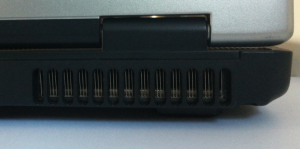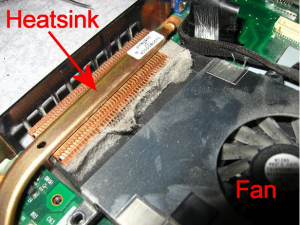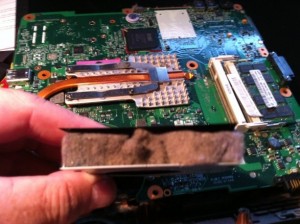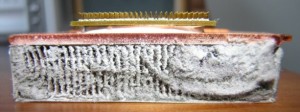With laptops becoming more and more popular they are also causing issues such as overheating to become a common problem. Symptoms of an overheated laptop include:
- The laptop is extremely hot to the touch, especially around the fan area.
- The fan seems to be running constantly, and at high speed making it noisy.
- The laptop shuts off by itself when doing nothing.
- The laptop shuts off when doing intensive work such as playing games or movies.
- Overheating or shutdown problems become worse over time, and happen more often.
So what causes the overheating?
Some of the key parts of any computer get hot as they operate, in particular the Central Processor (CPU) that does most of the work, and the Graphics Processor (GPU) that displays the picture on the screen. In a laptop everything is packed into a small space and this causes issues getting rid of this heat. The laptop has inside a fan and some metal grilles, called  a heatsink, designed to draw cold air from outside the case, over the hot metal grilles and blow the heat out of the vents. You can usually see the copper or silver coloured metal grilles through the vents in the side, rear or underneath your laptop.
a heatsink, designed to draw cold air from outside the case, over the hot metal grilles and blow the heat out of the vents. You can usually see the copper or silver coloured metal grilles through the vents in the side, rear or underneath your laptop.
When the laptop is new, the fan blows air easily through the heatsink, it efficiently cools the hot parts of the laptop, and everything works well. Unfortunately over time the heatsink becomes blocked by dust, fluff, pet hair etc. Now the fan cannot blow air through the gaps in the heatsink properly and isn’t able to cool the laptop as it should. Eventually the temperature inside the laptop gets higher and higher, reaching unacceptable levels and the laptop will shut itself down to prevent damage. Here are some pictures inside a laptop of a typical heatsink (left hand column) and fan (right hand column) covered in dust –
 |
 |
 |
 |
This dust is usually not visible from outside as the fan sucks air in from underneath the laptop and out through the heatsink, so the dust ends up stuck inside as you can see in the left hand picture.
Where you use the laptop can be just as important a cause of overheating. Most laptops draw cold air in through slots or vents underneath the base, and the feet are designed to keep a gap of a few millimetres from the surface that the laptop is sitting on so that air can circulate easily. If you put the laptop on a soft surface like a bed, carpet, your laptop or a sofa cushion these slots can become blocked and cool air cannot enter and the laptop gets hotter and hotter.
What you are doing can be important too. Just writing a document, checking your email or Facebook for example doesn’t make the laptop work very hard, so it doesn’t heat up very much. On the other hand, playing games or videos generates much more heat and this is often when you first start to experience overheating problems.
Can it be repaired?
Yes it certainly can be and the solution is relatively straightforward – the fan and heatsink assembly just needs a through clean to remove the dust and dirt. Just blowing compressed air through the grill just pushes the dust further into the laptop causing more issues. You need to disassemble the unit as the heat sink and fan are often buried deep inside the laptop, it does take experience and the right tools to take it all apart and reassemble it without causing other problems along the way. We do this kind of work all the time and can clean the fan and heatsink so that it will work at maximum efficiency and cool the laptop just as it did when new.
How can I avoid overheating?
Probably the most important advice is to avoid using the laptop on any kind of soft surface – the carpet, the sofa, the bed for example. Not only are these wonderful sources of the dust and fluff which causes the problem in the first place, but as mentioned above, they block the vents underneath the laptop through which the cooling air is drawn. Always try to use the laptop on a hard surface like a table, a desk, or if you are on the sofa or other soft surface, put it on a tray. This will ensure that there is a gap under the laptop to allow air into the vents so that the fan and heatsink can do their job and keep things at an even temperature .
If you have any questions please contact us at
su*****@dp*********.au
. and we’ll be happy to help.
Thank you to Neil Harrison of Tekwise on which this article was based.
